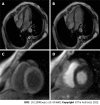Unusual course of congenital complete heart block in an adult: A case report
- PMID: 35979314
- PMCID: PMC9294914
- DOI: 10.12998/wjcc.v10.i19.6602
Unusual course of congenital complete heart block in an adult: A case report
Abstract
Background: Congenital complete heart block (CCHB) with normal cardiac structure and negativity for anti-Ro/La antibody is rare. Additionally, CCHB is much less frequently diagnosed in adults, and its natural history in adults is less well known.
Case summary: A 23-year-old woman was admitted to our hospital for frequent syncopal episodes. She had bradycardia at the age of 1 year but had never had impaired exercise capacity or a syncopal episode before admission. The possible diagnosis of acquired complete atrioventricular block was carefully ruled out, and then the diagnosis of CCHB was made. According to existing guidelines, permanent pacemaker implantation was recommended, but the patient declined. With regular follow-up for 28 years, the patient had an unusually good outcome without any invasive intervention or medicine. She had an uneventful pregnancy and led a normally active life without any symptoms of low cardiac output or syncopal recurrence.
Conclusion: This case implies that CCHB in adulthood may have good clinical outcomes and does not always require permanent pacemaker implantation.
Keywords: Acquired complete atrioventricular block; Case report; Congenital complete heart block; Pacemaker implantation; Syncope.
©The Author(s) 2022. Published by Baishideng Publishing Group Inc. All rights reserved.
Conflict of interest statement
Conflict-of-interest statement: The authors declare that they have no conflicts of interest.
Figures



Similar articles
-
Congenital heart block: Pace earlier (Childhood) than later (Adulthood).Trends Cardiovasc Med. 2020 Jul;30(5):275-286. doi: 10.1016/j.tcm.2019.06.006. Epub 2019 Jun 20. Trends Cardiovasc Med. 2020. PMID: 31262557 Review.
-
[A case of congenital complete heart block in a mother with anti-52 kD SS-A/Ro antibodies].Nihon Rinsho Meneki Gakkai Kaishi. 1997 Oct;20(5):437-41. doi: 10.2177/jsci.20.437. Nihon Rinsho Meneki Gakkai Kaishi. 1997. PMID: 9391307 Japanese.
-
Isolated congenital complete heart block in a five-year-old seronegative girl born to a woman seropositive for human immunodeficiency virus: a case report.J Med Case Rep. 2016 Oct 19;10(1):288. doi: 10.1186/s13256-016-1082-5. J Med Case Rep. 2016. PMID: 27756424 Free PMC article.
-
Congenital Heart Block.Card Electrophysiol Clin. 2021 Dec;13(4):691-702. doi: 10.1016/j.ccep.2021.07.006. Card Electrophysiol Clin. 2021. PMID: 34689896 Review.
-
Isolated congenital complete atrioventricular block in adult life. A prospective study.Circulation. 1995 Aug 1;92(3):442-9. doi: 10.1161/01.cir.92.3.442. Circulation. 1995. PMID: 7634461
References
-
- Rein AJ, Mevorach D, Perles Z, Gavri S, Nadjari M, Nir A, Elchalal U. Early diagnosis and treatment of atrioventricular block in the fetus exposed to maternal anti-SSA/Ro-SSB/La antibodies: a prospective, observational, fetal kinetocardiogram-based study. Circulation . 2009;119:1867–1872. - PubMed
-
- Santos-Pardo I, Villuendas R, Salvador-Corres I, Martínez-Morillo M, Olivé A, Bayes-Genis A. Anti-Ro/SSA antibodies and cardiac rhythm disturbances: Present and future perspectives. Int J Cardiol . 2015;184:244–250. - PubMed
-
- Chandler SF, Fynn-Thompson F, Mah DY. Role of cardiac pacing in congenital complete heart block. Expert Rev Cardiovasc Ther . 2017;15:853–861. - PubMed
-
- Manolis AA, Manolis TA, Melita H, Manolis AS. Congenital heart block: Pace earlier (Childhood) than later (Adulthood) Trends Cardiovasc Med . 2020;30:275–286. - PubMed
-
- Hamilton RM. Editorial commentary: Live better electrically? Trends Cardiovasc Med . 2020;30:287–288. - PubMed
Publication types
LinkOut - more resources
Full Text Sources
Research Materials

